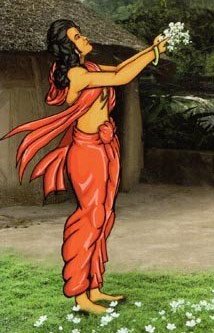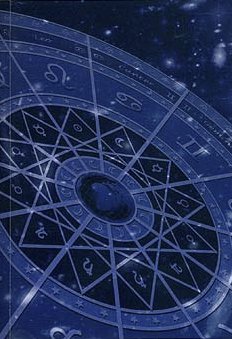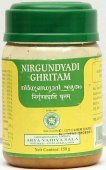Ramatha, Ramaṭha, Rāmaṭha, Ramaṭhā: 19 definitions
Introduction:
Ramatha means something in Hinduism, Sanskrit, Marathi, biology. If you want to know the exact meaning, history, etymology or English translation of this term then check out the descriptions on this page. Add your comment or reference to a book if you want to contribute to this summary article.
In Hinduism
Ayurveda (science of life)
Kalpa (Formulas, Drug prescriptions and other Medicinal preparations)
Source: Shodhganga: Edition translation and critical study of yogasarasamgrahaRāmaṭha (रामठ) is another name for “Hiṅgu” and is dealt with in the 15th-century Yogasārasaṅgraha (Yogasara-saṅgraha) by Vāsudeva: an unpublished Keralite work representing an Ayurvedic compendium of medicinal recipes. The Yogasārasaṃgraha [mentioning rāmaṭha] deals with entire recipes in the route of administration, and thus deals with the knowledge of pharmacy (bhaiṣajya-kalpanā) which is a branch of pharmacology (dravyaguṇa).
Toxicology (Study and Treatment of poison)
Source: Shodhganga: Kasyapa Samhita—Text on Visha ChikitsaRāmaṭha (रामठ) or “asafoetida” is the name of an herbal ingredient which is included in a (snake) poison antidote recipe, according to the Kāśyapa Saṃhitā: an ancient Sanskrit text from the Pāñcarātra tradition dealing with both Tantra and Viṣacikitsā—an important topic from Āyurveda which deals with the study of Toxicology (Viṣavidyā or Sarpavidyā).—Several herbal formulations have been recommended in the segment exclusively for lepa or ointment to counter poison. According to Kāśyapasaṃhitā (verse VIII.44), “A potion prepared from the latex of Snuhī, salt, asafoetida (rāmaṭha), black jeera and mixed with the juice of the leaf of Paiśāca, when applied, nullifies poison”.
Unclassified Ayurveda definitions
Source: Wisdom Library: Āyurveda and botanyRāmaṭha (रामठ) is another name (synonym) for Hiṅgu, which is a Sanskrit name for the plant Ferula assa-foetida (asafoetida). This synonym was identified by Narahari in his 13th-century Rājanighaṇṭu (verses 6.72-75), which is an Ayurvedic medicinal thesaurus. The synonym can also be divided as two separate synonyms, Śūlaghna and Gulmaghna.

Āyurveda (आयुर्वेद, ayurveda) is a branch of Indian science dealing with medicine, herbalism, taxology, anatomy, surgery, alchemy and related topics. Traditional practice of Āyurveda in ancient India dates back to at least the first millenium BC. Literature is commonly written in Sanskrit using various poetic metres.
Purana and Itihasa (epic history)
Source: archive.org: Puranic Encyclopedia1) Ramaṭha (रमठ).—A mleccha tribe who lived in the kingdom of Māndhātā. (Śānti Parva, Chapter 61, Verse 14).
2) Rāmaṭha (रामठ).—People of a low caste (mlecchas) who lived in South India during Purāṇic times. Nakula, subjugated this caste, and from that day onwards they became devoted to the Pāṇḍavas. They were invited to the Rājasūya conducted by Yudhiṣṭhira. (Vana Parva, Chapter 51, Verse 25).
Source: Cologne Digital Sanskrit Dictionaries: The Purana IndexRāmaṭha (रामठ).—A northern tribe.*
- * Matsya-purāṇa 114. 42.
Ramaṭhā (रमठा) is a name mentioned in the Mahābhārata (cf. III.48.21, VIII.51.18) and represents one of the many proper names used for people and places. Note: The Mahābhārata (mentioning Ramaṭhā) is a Sanskrit epic poem consisting of 100,000 ślokas (metrical verses) and is over 2000 years old.

The Purana (पुराण, purāṇas) refers to Sanskrit literature preserving ancient India’s vast cultural history, including historical legends, religious ceremonies, various arts and sciences. The eighteen mahapuranas total over 400,000 shlokas (metrical couplets) and date to at least several centuries BCE.
Kavya (poetry)
Source: Shodhganga: The Kavyamimamsa of RajasekharaRamatha (रमथ) is the name a locality mentioned in Rājaśekhara’s 10th-century Kāvyamīmāṃsā.—In the Bālābhārata (1.7), Rājaśekhara posits this region in the northern India, which may be represents the country parts near the Raumaka Mountain. The Viṣṇu-Purāṇa also mentions Ramas along with the Huṇas, Salvas, Sakalas in the Northern India. These Ramas may belong to foreign tribes and identified with the people living at Aornos or the ruined fortress of Ranigat. So it may be possible that Rājaśekhara’s described Ramatha may represent the Rama tribe of the Viṣṇu-Purāṇa.

Kavya (काव्य, kavya) refers to Sanskrit poetry, a popular ancient Indian tradition of literature. There have been many Sanskrit poets over the ages, hailing from ancient India and beyond. This topic includes mahakavya, or ‘epic poetry’ and natya, or ‘dramatic poetry’.
Jyotisha (astronomy and astrology)
Source: Wisdom Library: Brihat Samhita by VarahamihiraRamaṭha (रमठ) refers to a country belonging to “Apara or Aparadeśa (western divisions)” classified under the constellations of Jyeṣṭhā, Mūla and Pūrvāṣāḍha, according to the system of Kūrmavibhāga, according to the Bṛhatsaṃhitā (chapter 14), an encyclopedic Sanskrit work written by Varāhamihira mainly focusing on the science of ancient Indian astronomy astronomy (Jyotiṣa).—Accordingly, “The countries of the Earth beginning from the centre of Bhāratavarṣa and going round the east, south-east, south, etc., are divided into 9 divisions corresponding to the 27 lunar asterisms at the rate of 3 for each division and beginning from Kṛttikā. The constellations of Jyeṣṭhā, Mūla and Pūrvāṣāḍha represent the western divisions consisting of [i.e., Ramaṭha] [...]”.

Jyotisha (ज्योतिष, jyotiṣa or jyotish) refers to ‘astronomy’ or “Vedic astrology” and represents the fifth of the six Vedangas (additional sciences to be studied along with the Vedas). Jyotisha concerns itself with the study and prediction of the movements of celestial bodies, in order to calculate the auspicious time for rituals and ceremonies.
Biology (plants and animals)
Source: Google Books: CRC World Dictionary (Regional names)Ramatha in India is the name of a plant defined with Alangium salviifolium in various botanical sources. This page contains potential references in Ayurveda, modern medicine, and other folk traditions or local practices It has the synonym Karangolum mohillae (Tul.) Kuntze (among others).
Example references for further research on medicinal uses or toxicity (see latin names for full list):
· Enumeratio Plantarum Zeylaniae: (1859)
· Das Pflanzenreich (1910)
If you are looking for specific details regarding Ramatha, for example diet and recipes, chemical composition, health benefits, extract dosage, side effects, pregnancy safety, have a look at these references.

This sections includes definitions from the five kingdoms of living things: Animals, Plants, Fungi, Protists and Monera. It will include both the official binomial nomenclature (scientific names usually in Latin) as well as regional spellings and variants.
Languages of India and abroad
Marathi-English dictionary
Source: DDSA: The Molesworth Marathi and English Dictionaryrāmāṭhā (रामाठा) [or ठ्या, ṭhyā].—A wild flowering shrub. It bears a yellow tufted flower, and abounds on the Mahabaleshwar hills. Gnidia eriocephala.
Marathi is an Indo-European language having over 70 million native speakers people in (predominantly) Maharashtra India. Marathi, like many other Indo-Aryan languages, evolved from early forms of Prakrit, which itself is a subset of Sanskrit, one of the most ancient languages of the world.
Sanskrit dictionary
Source: DDSA: The practical Sanskrit-English dictionaryRamaṭha (रमठ).—[rameḥ aṭhaḥ Uṇādi-sūtra 1.97] Asa Fœtida (hiṅgu).
Derivable forms: ramaṭham (रमठम्).
--- OR ---
Rāmaṭha (रामठ).—Asa Fœtida (hiṅgu).
Derivable forms: rāmaṭhaḥ (रामठः), rāmaṭham (रामठम्).
Source: Cologne Digital Sanskrit Dictionaries: Edgerton Buddhist Hybrid Sanskrit DictionaryRamaṭha (रमठ).—(name of a people, Sanskrit; listed among dasyu peoples Mahāvastu i.171.14), sc. lipi, the script of the R. people: Mahāvastu i.135.7.
Source: Cologne Digital Sanskrit Dictionaries: Shabda-Sagara Sanskrit-English DictionaryRamaṭha (रमठ).—n.
(-ṭhaṃ) Asafœtida. “hiṅguni”. E. ram to sport, aṭan aff.
--- OR ---
Rāmaṭha (रामठ).—n.
(-ṭhaṃ) Asafœtida. E. ram to please, aṭha Unadi aff., and the radical vowel lengthened.
Source: Cologne Digital Sanskrit Dictionaries: Cappeller Sanskrit-English DictionaryRāmaṭha (रामठ).—[masculine] [plural] [Name] of a people.
Source: Cologne Digital Sanskrit Dictionaries: Monier-Williams Sanskrit-English Dictionary1) Ramatha (रमथ):—[from ram] m. joy, delight, [cf. Lexicographers, esp. such as amarasiṃha, halāyudha, hemacandra, etc.]
2) Ramaṭha (रमठ):—m. [plural] Name of a people in the west of India (also read ramaṭa, rāmaṭha), [Mahābhārata; Varāha-mihira’s Bṛhat-saṃhitā]
3) n. = rāmaṭha, Asa Foetida, [cf. Lexicographers, esp. such as amarasiṃha, halāyudha, hemacandra, etc.]
4) Rāmaṭha (रामठ):—[from rāma] mn. Asa Foetida, [cf. Lexicographers, esp. such as amarasiṃha, halāyudha, hemacandra, etc.]
5) [v.s. ...] m. Alangium Hexapetalum, [cf. Lexicographers, esp. such as amarasiṃha, halāyudha, hemacandra, etc.]
6) [v.s. ...] m. [plural] Name of a people, [Mahābhārata]
Source: Cologne Digital Sanskrit Dictionaries: Yates Sanskrit-English Dictionary1) Ramaṭha (रमठ):—(ṭhaṃ) 1. n. Asafoetida.
2) Rāmaṭha (रामठ):—(ṭhaṃ) 1. n. Asafoetida.
[Sanskrit to German]
Sanskrit, also spelled संस्कृतम् (saṃskṛtam), is an ancient language of India commonly seen as the grandmother of the Indo-European language family (even English!). Closely allied with Prakrit and Pali, Sanskrit is more exhaustive in both grammar and terms and has the most extensive collection of literature in the world, greatly surpassing its sister-languages Greek and Latin.
Kannada-English dictionary
Source: Alar: Kannada-English corpusRāmaṭha (ರಾಮಠ):—
1) [noun] the plant Ferula assafoetida of Apiaceae family; asafoetida plant.
2) [noun] the bad-smelling gum resin obtained from this plant, used in seasoning food; asafoetida.
Kannada is a Dravidian language (as opposed to the Indo-European language family) mainly spoken in the southwestern region of India.
See also (Relevant definitions)
Starts with: Ramathadhvani, Ramathaphala.
Ends with: Aramatha, Cakramatha, Draupadipramatha, Giragiramatha, Pramatha, Shuramatha, Varamatha, Vipramatha.
Full-text (+14): Ramathadhvani, Ramata, Yavana, Rameti, Inkuramam, Iramatam, Mathara, Ramathi, Jringa, Huna, Vipasha, Shatadru, Ambashta, Srughna, Purvabhaga, Vipashasarit, Pauraba, Matsyardha, Bharata, Pashcardha.
Relevant text
Search found 16 books and stories containing Ramatha, Ramaṭha, Rāmaṭha, Ramaṭhā, Rāmāṭhā; (plurals include: Ramathas, Ramaṭhas, Rāmaṭhas, Ramaṭhās, Rāmāṭhās). You can also click to the full overview containing English textual excerpts. Below are direct links for the most relevant articles:
List of Mahabharata people and places (by Laxman Burdak)
The Agni Purana (by N. Gangadharan)
Kavyamimamsa of Rajasekhara (Study) (by Debabrata Barai)
Part 8.7 - The region of Uttarāpatha (northern part) < [Chapter 5 - Analyasis and Interpretations of the Kāvyamīmāṃsā]
Appendix 2 - Identification of Geographical names mentioned in the Kāvyamīmāṃsā
Manusmriti with the Commentary of Medhatithi (by Ganganatha Jha)
Verse 3.266 < [Section XXI - Relative Merits of the Offering-Materials]
Mahabharata (English) (by Kisari Mohan Ganguli)
Section XXXI < [Digvijaya Parva]
Section LXV < [Rajadharmanusasana Parva]
Section LI < [Indralokagamana Parva]
Brihat Samhita (by N. Chidambaram Iyer)
Related products

